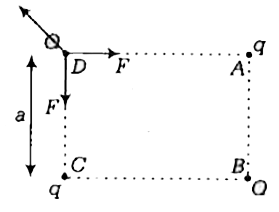Charges Q are placed at the ends of a diagonal of a square and charges q are placed at the other two corners. The condition for the net electric force on Q to be zero is Solution in Telugu
Q=−2√2q,q being negative
Q=−q√2,q being negative
Q=2√2q,q being negative
Q = 2q ,q being negative
Net force on D due to A and B R=K√2Qqa2

Force on D due to B =KQ22a2
For net electric field on D to be zero
K[Q22a2+√2Qqa2]=0
⇒ Q2+√2q=0
Q=−2√2q
∴ q should be negative.
Topper's Solved these Questions
Similar Questions
Choose the incorrect statement from the following
View SolutionElectron microscope is based on the principle of
View SolutionA charge Q is place at each of the opposite corners of a square. A charge q is placed at each of the other two corners. If the net electrical force on Q is zero, then Q/q equals:
View SolutionA charges Q is placed at each of the two opposite corners of a square. A charge q is placed to each of the other two corners. If the resultant force on each charge q is zero, then
View SolutionCharges Q−q,Q,−q are placed at the corners A,B,C,D of a square respectively. If the resultant force on the charge Q is zero due to other charges, what is the relation between Q and q?
View SolutionA charge +q is fixed to each of three corners of a square .On the empty corner a charge Q is placed such that there is no net electrostatic force acting on the diagonally opposite charge then
View Solutionएक वर्ग के दो विपरीत कोनों पर आवेश Q रखा है तथा शेष दो कोनों पर आवेश q रखा है। यदि आवेश Q पर नैट विद्युत् बल शून्य है तो Q/q का मान है :
View SolutionA charge Q is placed at each of the opposite corners of square. A charge q is placed at each of the other two corners. If the net electrical force on Q is zero , then Q/q equals.
View Solutionदो समान बिन्दु आवेश Q=+√2μC एक वर्ग के दो विपरीत कोनो पर रखे जाते है q दो अन्य कोनों पर रखे जाते है Q पर परिणामी बल शून्य होने के लिए q का मान क्या होगा ?
View SolutionA charge Q is place at each of the opposite corners of a square. A charge q is placed at each of the other two corners. If the net electrical force on Q is zero, then Q//q equals:
View SolutionA charage Q is placed at each of the opposite corners of a square. A charge q is placed at each of the other two corners. If the net electric force on Q is zero, then Q/q equals:
View SolutionFour charges Q, q, Q and q are placed at the corners A, B, C and D of a square ABCD. If the resultant electric force on the charge at the corner C is zero, find the value of Q/q.
View SolutionCharges Q are placed at the ends of a diagonal of a square and charges q are placed at the other two corners. The conditions for the net electric force on Q to be zero is
View SolutionA charge Q is placed at each of two opposite comers • of a square. A charge q is. placed at each of the other two comers. If the net electric force on Q is zero, then Q/q equals to:
View SolutionA charges Q is placed at each of the two opposite corners of a square. A charge q is placed to each of the other two corners. If the resultant force on each charge q is zero, then
View Solution